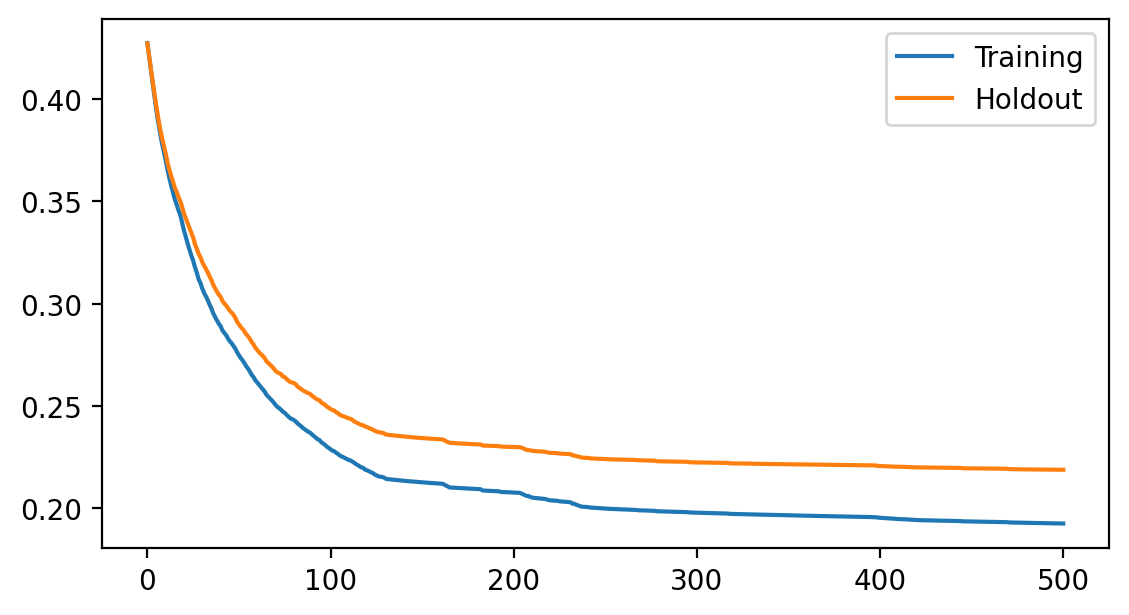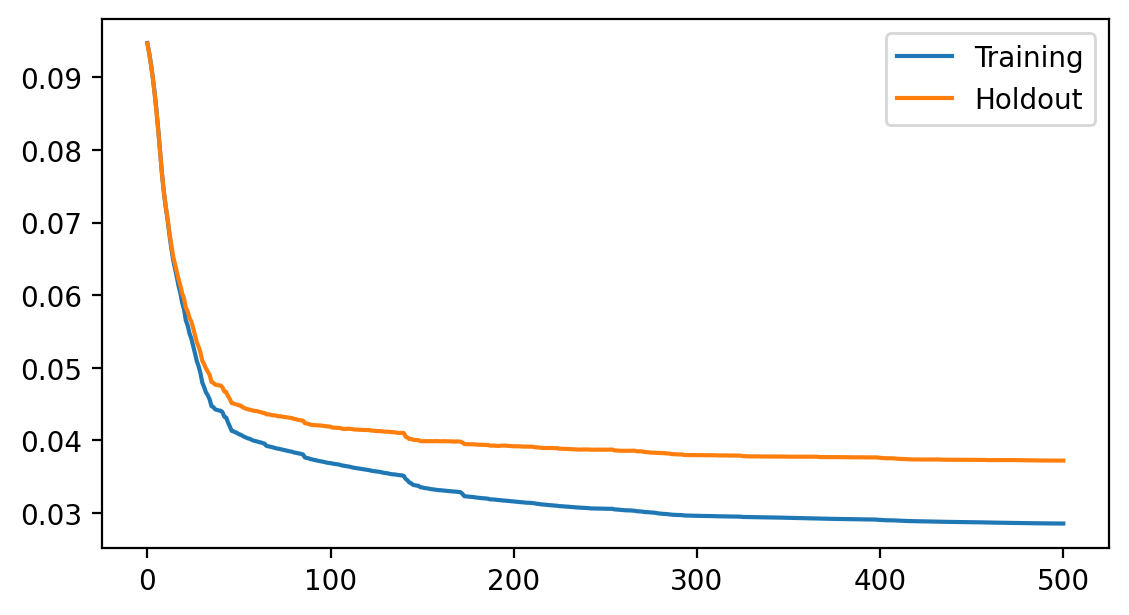Binary Target Boosting with Custom Model Callback Wrapper¶
This example will demonstrate the following uses of the library:
Supervised learning with a binary target
Wrapping a custom model callback to perform CV at each boosting iteration
Interchanging link and loss function
import warnings
import numpy as np
import pandas as pd
import matplotlib.pyplot as plt
import scipy.stats as scst
from sklearn.tree import DecisionTreeRegressor
from sklearn.model_selection import GridSearchCV
from sklearn.preprocessing import scale
from sklearn.datasets import make_classification
from genestboost import BoostedModel
from genestboost.link_functions import LogitLink, CLogLogLink
from genestboost.loss_functions import LogLoss, LeakyBetaLoss
%matplotlib inline
Create a dummy classification dataset¶
X, y = make_classification(n_samples=20000,
n_features=50,
n_informative=20,
weights=(0.85, 0.15),
random_state=11)
X = scale(X)
Create a Custom Model Wrapper¶
Here, let’s create a custom model wrapper that will allow us to perform
a 3-fold cross-validation over decision tree hyperparameters at each
model iteration. We just need to make sure that we provide a callback
that returns a model with a fit and predict method. GridSearchCV has
a fit method, and after the fit we can simply take the best returned
model.
# model_callback
class CVDecisionTree:
def __init__(self, param_grid, folds=3, n_jobs=-1):
self._param_grid = param_grid # parameter grid for CV
self._folds = folds # number of CV folds to use in grid search
self._n_jobs = n_jobs # number of jobs to use
self._model = None
def fit(self, X, y, weights=None):
new_model = GridSearchCV(
estimator=DecisionTreeRegressor(splitter="random", random_state=17),
param_grid = self._param_grid,
cv=self._folds,
n_jobs = self._n_jobs,
refit=True,
)
new_model.fit(X, y, weights)
new_model = new_model.best_estimator_ # refit=True to get the best estimator
self._model = new_model
# new model should have a predict method, but we will implement our own
return self
def predict(self, X):
return self._model.predict(X)
# create param_grid for model_callback kwargs
param_grid = {
'min_samples_split': [10, 20, 50],
"max_depth": [2, 3, 5],
}
# model_callback_kwargs
model_callback_kwargs = {"param_grid": param_grid}
Fit the model using LogitLink and LogLoss¶
First, let’s fit a model for the binary target using the same link/loss function as ordinary logistic regression.
with warnings.catch_warnings(): # catch sklearn utils warning
warnings.simplefilter("ignore")
# fit model
model = BoostedModel(
link=LogitLink(),
loss=LogLoss(),
weights="newton",
alpha=2.0,
step_type="decaying",
validation_fraction=0.30,
validation_stratify=True,
validation_iter_stop=20,
model_callback=CVDecisionTree, # use our customer wrapper
model_callback_kwargs=model_callback_kwargs, # with our param grid
)
model.fit(X, y, iterations=500)
preds = model.predict(X)
print("Number of model iterations: {:d}".format(model.get_iterations()))
Number of model iterations: 500
Plot the loss history¶
fig = plt.figure(figsize=(6.5, 3.5), dpi=200)
ax = fig.add_subplot(111)
ax.plot(model.get_loss_history(), label=["Training", "Holdout"])
ax.legend(loc="best");

Try a Different Link and Loss Pair¶
To demonstrate how easy it is to switch the link and loss function, let’s refit the model with CLogLogLink and BetaLoss functions.
with warnings.catch_warnings(): # catch sklearn utils warning
warnings.simplefilter("ignore")
# fit model
model = BoostedModel(
link=CLogLogLink(),
loss=LeakyBetaLoss(alpha=5.0, beta=5.0),
weights="none",
alpha=1.0,
step_type="decaying",
validation_fraction=0.30,
validation_stratify=True,
validation_iter_stop=20,
model_callback=CVDecisionTree, # use our customer wrapper
model_callback_kwargs=model_callback_kwargs, # with our param grid
)
model.fit(X, y, iterations=500)
preds = model.predict(X)
print("Number of model iterations: {:d}".format(model.get_iterations()))
Number of model iterations: 500
Plot the loss history again for CLogLog and LeakyBetaLoss¶
fig = plt.figure(figsize=(6.5, 3.5), dpi=200)
ax = fig.add_subplot(111)
ax.plot(model.get_loss_history(), label=["Training", "Holdout"])
ax.legend(loc="best");
